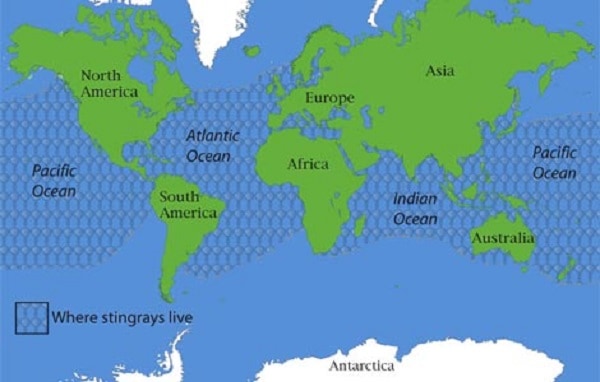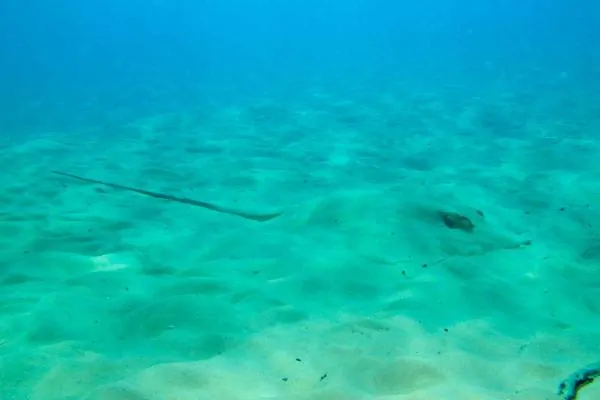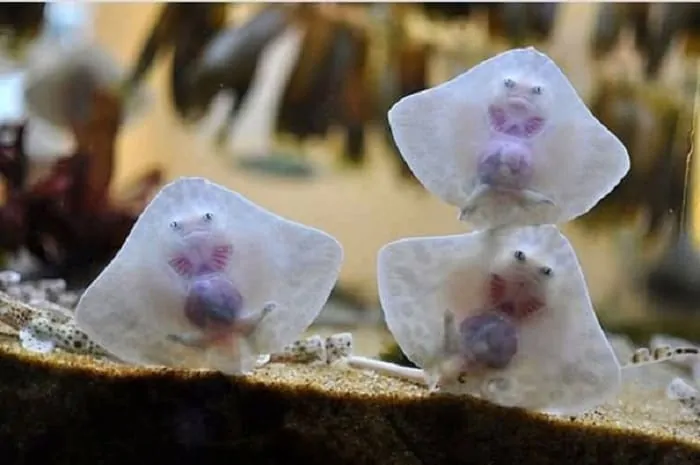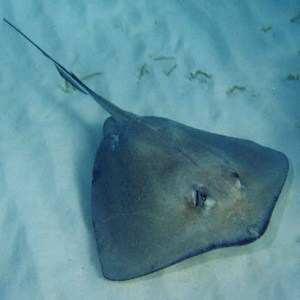
- Scientific Name: Mylioatiformes
- Classification: Fish
- Rank: Suborder
- Habitat: Shallow coastal waters in temperate seas
- Diet: Carnivore
- Weight: Up to 790 pounds (350 kilograms)
- Largest: 6.5 feet in length
- Speed: 30 miles per hour
- Lifespan: 15 to 25 years
- Conservation Status: Threatened
- Types: There Are More Than 70 Species of Stingray
- Habitat: Stingrays can be Found in Freshwater
- Movement: Stingrays Are Generally Inactive but are Graceful When They Do Move
- Migration: Stingrays Migrate When the Weather Gets Cooler
- Predators: Stingrays Have Few Natural Predators
- Protection: Stingrays Might Look Gentle, But Their Venom Can Be Fatal
- Adaptations: Stingrays Use Camouflage for Protection and Hunting
- Hunting: Stingrays Don’t Use Their Eyes When Hunting
- Anatomy: Stingrays Don’t Have Bones
- Behavior: Stingrays Are Not Sea Socialites, Preferring to Be Alone
- Newborn Stingrays Can Fend for Themselves
- A New Diet? Stingrays Are Edible
- Stingray Skin Is Used in Japanese Swords
- Stingrays’ Venom Was Used for Medicinal Purposes in Ancient Greece
- A Stingray Was the Downfall of the Greek Hero Odysseus
Stingray Facts Infographics

There Are More Than 70 Species of Stingray

One of the most surprising stingray facts is that there are more than 70 species of stingrays in the world’s oceans. These species belong to eight families. The eight families of stingrays are: sixgill stingrays, eagle rays, deep water stingrays, butterfly rays, stingarees, river stingrays, round rays, and whiptail rays.
Stingrays can be Found in Freshwater

Stingrays are generally found in warm ocean waters. Their range tends to be in tropical and subtropical coastal regions. However, one of the more surprising stingray facts is that some species of stingrays live in freshwater rivers.
Stingrays Are Generally Inactive but are Graceful When They Do Move
Stingrays are inactive for the vast majority of time. They can usually be found lying on the ocean floor, partially buried in the sand. Any visible movement is generally the result of the sway of the tide. When they do move purposely, however, stingrays usually undulate their bodies in a wavelike movement. Some stingrays will flap their sides, much like wings. Although a stingray’s tail can be used to help it maneuver in the water, its main purpose is for protection.
Stingrays Migrate When the Weather Gets Cooler
Stingrays are generally found in warmer waters, but this does not mean that they don’t migrate. When the weather gets cooler, stingrays tend to move into deeper waters.
Stingrays Have Few Natural Predators
Because they tend to be quite large, stingrays do not have many natural predators. By lying on the ocean floor, usually partially covered in sand, stingrays are generally able to hide quite well from potential predators. A stingray’s main predators, apart from humans, are sea lions, sharks, seals, and large carnivorous fish.
Stingrays Might Look Gentle, But Their Venom Can Be Fatal

Stingrays are usually found lying on the ocean floor. They might appear calm and gentle, but that doesn’t mean they aren’t dangerous. The spine of a stingray, which is also known as a barb, can have serrated edges and a sharp point. The spine itself can be dangerous to humans. The underside may produce the stingray’s venom. This venom can be fatal for humans. In addition, the venom remains deadly even after the stingray’s death.
Stingrays Use Camouflage for Protection and Hunting

Stingrays use camouflage to protect themselves from predatory sharks and larger rays. The coloring of stingrays generally mimics the seafloor, enabling them to be hidden from sight. This camouflage is not just for hiding from predators. Stingrays also lie in wait for unsuspecting prey. A stingray’s diet consists of marine creatures such as clams, oysters, shrimp, crabs and mussels.
Stingrays Don’t Use Their Eyes When Hunting
A stingray’s eyes are located on its dorsal side. Its mouth, nostrils and gills are found on its underbelly. It is therefore thought that a stingray’s eyes are not a vital element when it comes to hunting. One of the most fascinating stingray facts is that these creatures have electrical sensors, just like sharks. These sensors are known as ampullae of Lorenzini and are located around a stingray’s mouth. These sensors detect the natural electrical charges emitted by potential prey.
Stingrays Don’t Have Bones
Stingrays do not have bones like other fish. Instead, stingrays are cartilaginous, much like sharks. This cartilage supports their entire body. Stingrays have a flat round shape thanks to the large fins that run the length of their bodies.
Stingrays Are Not Sea Socialites, Preferring to Be Alone
Stingrays are generally very solitary creatures. However, groups of stingrays have sometimes been observed swimming together. A group of stingrays is called a school.
Newborn Stingrays Can Fend for Themselves

Female stingrays tend to give birth once a year. In general, each female will give birth to 2 to 6 offspring. Baby stingrays are quite large and well developed by the time they are born. This means that they already resemble adult stingrays, albeit on a smaller scale. One of the most incredible stingray facts is that these newborns are able to fend for themselves from birth!
A New Diet? Stingrays Are Edible
Of all stingray facts, one of the most surprising is that stingrays are actually edible. In fact, many cuisines around the world make use of stingray in their dishes. Stingray is widely eaten, for example, in Malaysia and Singapore. In this part of the world, it’s common to grill the stingray over coals and serve it with spicy sauces.
Stingray Skin Is Used in Japanese Swords
Stingrays have very tough, leathery skin. For this reason, it is used in the manufacture of a variety of products. Some examples of products that feature stingray skin include boots, wallets, belts, shoes, jackets, and even cellphone cases. In addition, stingray skin is often used as an under layer on Japanese swords.
Stingrays’ Venom Was Used for Medicinal Purposes in Ancient Greece
One of the more intriguing stingray facts is that their venom was used in dental practice in Ancient Greece. A stingray’s venom is stored in its spine. Dentists in Ancient Greece used this venom as an anesthetic for their patients.
A Stingray Was the Downfall of the Greek Hero Odysseus
The fatal nature of a stingray’s venom played an important role in Greek mythology. According to Greek mythology, Odysseus was not only the king of Ithaca but a great hero. But even Odysseus was no match for the deadly venom of a stingray. Odysseus’ son, Telegonus, struck him with a spear, the tip of which was in fact the spine of a stingray. It was this that led to the death of Odysseus.
Stingray Facts – Facts about Stingrays Summary
 Stingrays are large cartilaginous fish found in warm coastal waters. These graceful fish are usually immobile, although they do migrate in cooler weather. Stingrays use their poisonous barbs for protection, and this poison has also been used by humans. In addition, people hunt stingrays for their flesh and skin. Apart from humans, stingrays have few predators.
Stingrays are large cartilaginous fish found in warm coastal waters. These graceful fish are usually immobile, although they do migrate in cooler weather. Stingrays use their poisonous barbs for protection, and this poison has also been used by humans. In addition, people hunt stingrays for their flesh and skin. Apart from humans, stingrays have few predators.
Was this page helpful?
Our commitment to delivering trustworthy and engaging content is at the heart of what we do. Each fact on our site is contributed by real users like you, bringing a wealth of diverse insights and information. To ensure the highest standards of accuracy and reliability, our dedicated editors meticulously review each submission. This process guarantees that the facts we share are not only fascinating but also credible. Trust in our commitment to quality and authenticity as you explore and learn with us.


